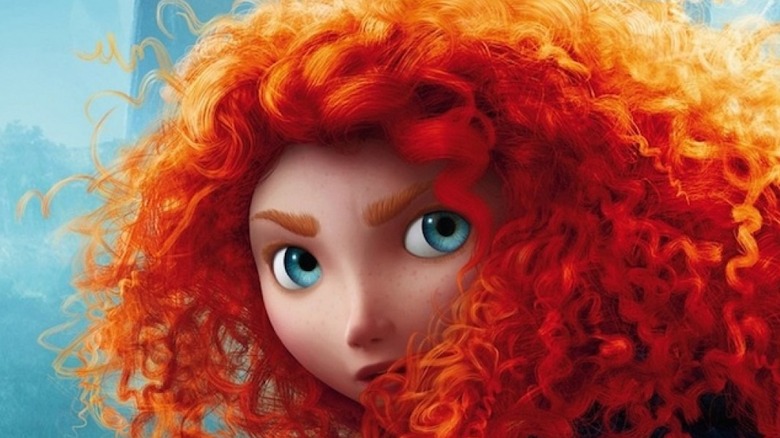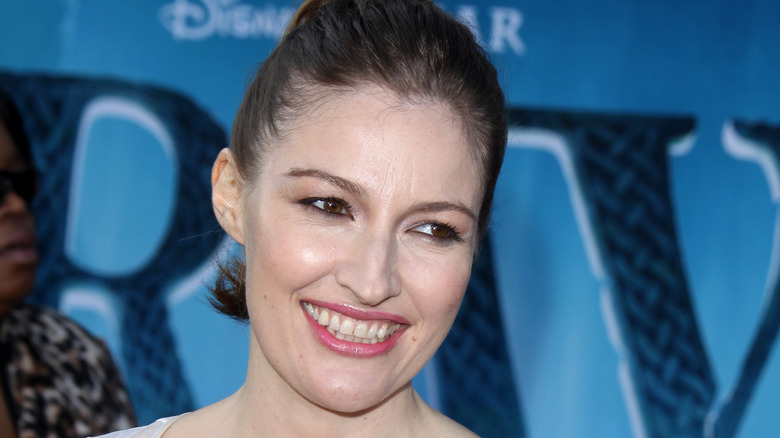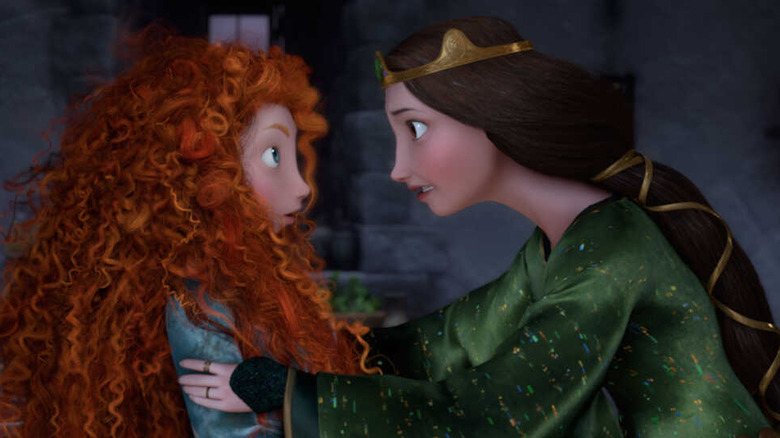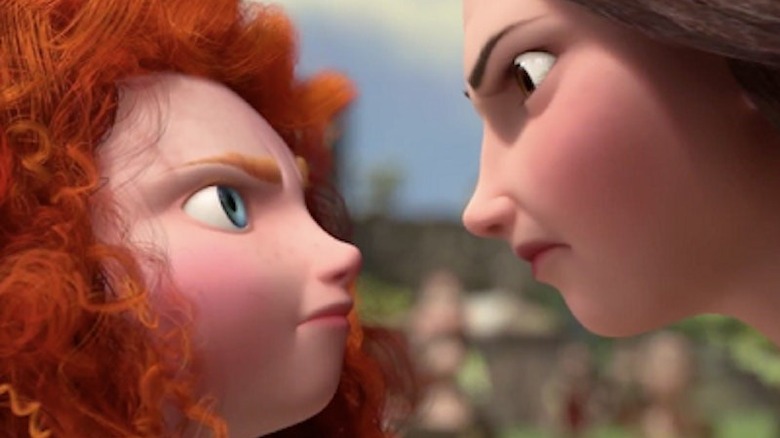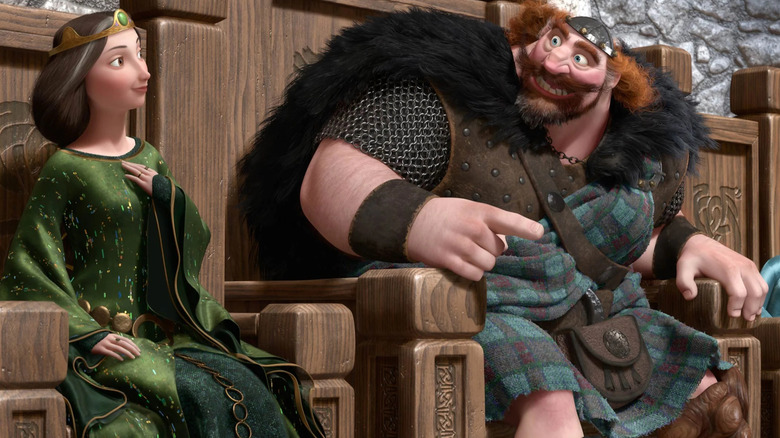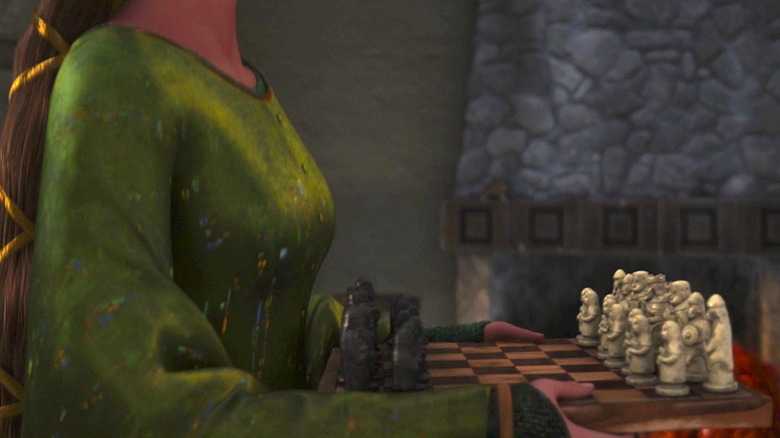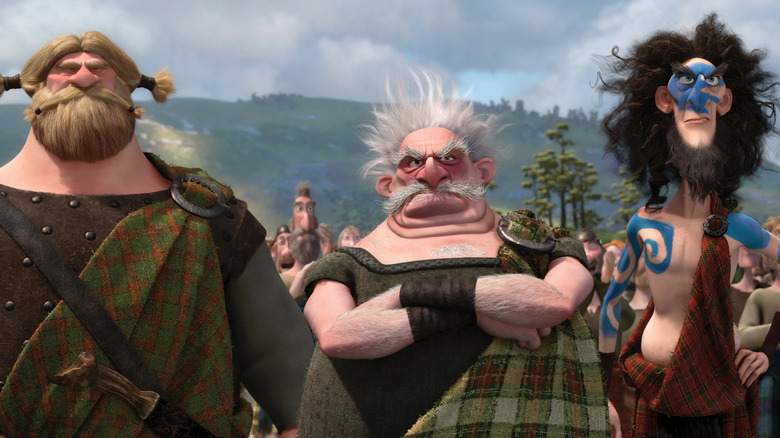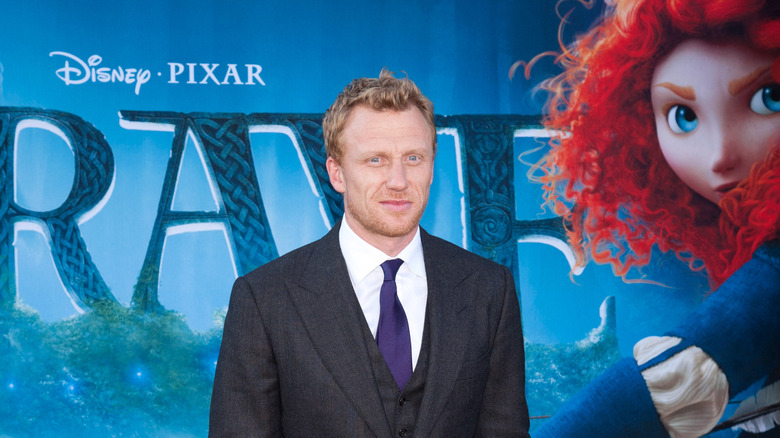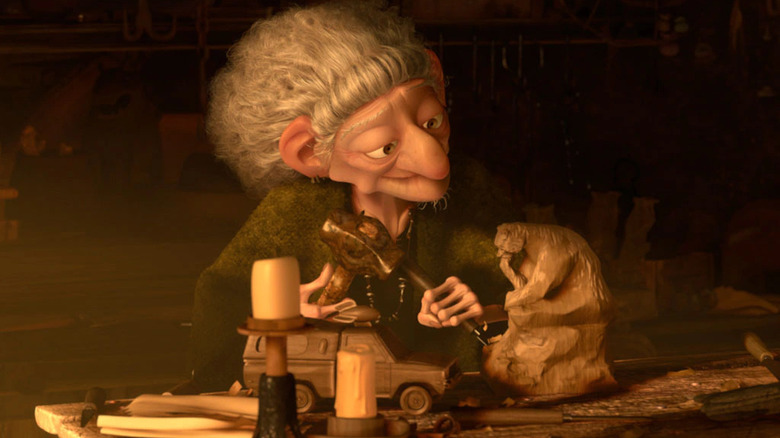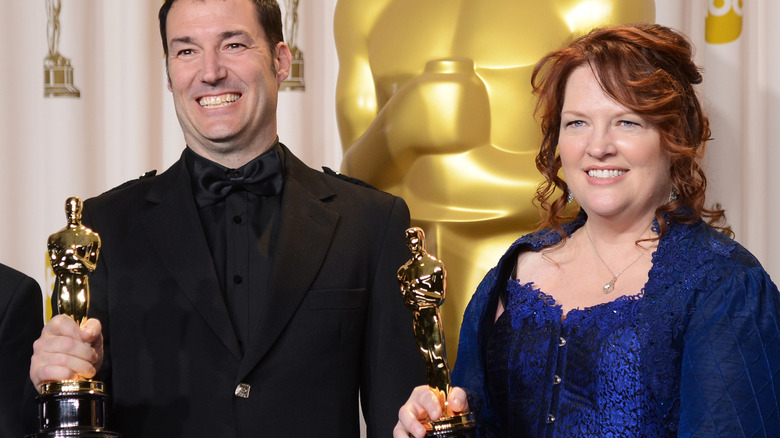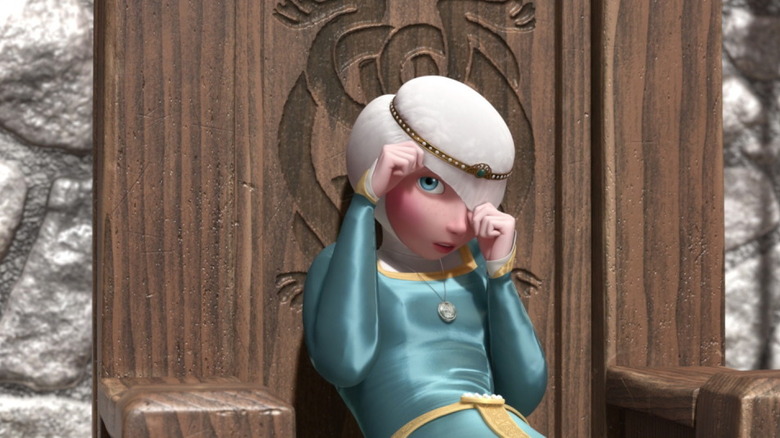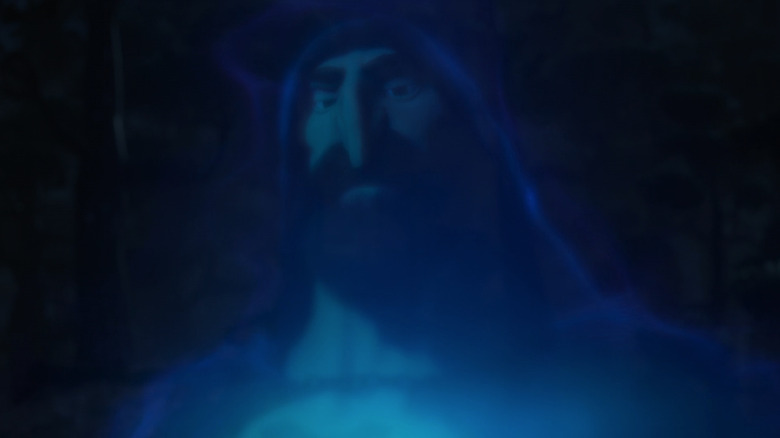Things In Brave That Only Adults Seem To Notice
2022 marks the 10th anniversary of the Disney/Pixar film "Brave," a stunningly beautiful movie set in the highlands of medieval Scotland. The story revolves around Merida, a princess of the Clan DunBroch who is fiercely independent, having become an expert rider and archer instead of a "proper" princess. Merida' parents, Queen Elinor and King Fergus, want her to marry one of the sons of the neighboring clans, but Merida absolutely refuses. Instead, she seeks out a witch that will help change her fate. But the spell isn't what she expects. Instead of changing her mother's mind, it changes her mother into a bear. Merida must find a way to break the spell or lose her mother for good.
"Brave" is a wonderful story of mother-daughter connections, but also a coming-of-age story. The battle between mother and daughter to understand one another is so relatable for many women that "Brave" is one of those movies that mothers may eventually show their daughters in order to help ease the passage of time and the growing pains of adulthood. But watching "Brave" as an adult and even as a parent is quite different than watching it as a kid. Here are some things only adults will notice about "Brave."
Who the famous voice cast includes
Like many other Disney and Pixar projects, "Brave" features a lot of famous voices. But a kid watching the movie wouldn't immediately be able to tell who is voicing who or what other projects these famous voices may have come from. Let's start with Merida herself, who is voiced by Kelly Macdonald. Adult fans may recognize her voice from other projects like HBO's "Boardwalk Empire," the Oscar-winning film "No Country for Old Men," or as the ghostly Helena Ravenclaw in the Harry Potter movies. But Macdonald wasn't the first choice to voice Merida. Reese Witherspoon was hired originally, but she apparently couldn't pull off the difficult Scottish accent, so they went with a native Scot instead.
Other recognizable voices include Billy Connolly as Merida's dad Fergus, Emma Thompson as Queen Elinor, Kevin McKidd of "Grey's Anatomy" as Lord MacGuffin, late night host Craig Ferguson as Lord Macintosh, and Hagrid himself, Robbie Coltrane, as Lord Dingwall. Another Harry Potter alum, Julie Walters, who plays supermom Molly Weasley in the series, takes on the voice of the witch in "Brave."
Merida is actually totally in the wrong
It's funny — when you grow up watching animated films with headstrong teenagers, you identify with the plight of the teenage leads. But as you age into adulthood, you develop a little more sympathy for the adults. As a grown-up, you might look a little more critically at Ariel's abandonment of her entire family and setting off to find a solution from a sea witch in "The Little Mermaid." You may also a little more skeptical of any Disney princess who wants to marry someone they just met — hello Cinderella, Aurora, and Snow White — and Merida is no exception.
Yes, Merida tried to talk to her mother about the fact that she didn't want to get married and how she didn't want the life Elinor was trying to push on her. But Merida also should have been a little more responsible when it came to seeking out a witch and magic to "change her fate." Turning her mother into a bear, even though she didn't know that would be the outcome, is all a little extreme, and she was definitely pretty wrong for trying to force magic on her own mother, especially when it could have been permanent and she'd have lost her forever.
...but Merida's mom is also wrong
That being said, Elinor should have definitely been more open minded and listened to her daughter more. Elinor was too rigid in her expectations, adherence to tradition, and insistence on Merida's marriage. Elinor refuses to even consider that, not only is Merida too young to get married (maybe in the modern sense, but maybe not in the medieval Scotland sense) but she also doesn't consider the idea that maybe Merida doesn't want to get married at all. How forward thinking would it have been for Elinor to consider that Merida may want to rule alone as queen, or that she may prefer to marry a woman? Obviously a Disney movie from 2012 wasn't ready to go there yet. But either way, Elinor's stubbornness really got in the way of forming a long-lasting relationship with her daughter.
Of course, Elinor didn't deserve to be turned into a bear as a result, but being a little more lenient might have helped. It's only natural that teenage girls reject their moms or act oppositional to the life their moms want for them. It's a relatively universal experience that the harder you push something on your kid, the more they might reject it. Merida was Elinor's oldest child, so perhaps she hadn't learned that lesson just yet.
Fergus should have helped more
Someone who could have helped a little more, however, was Fergus, Merida's father and the King... though we all know he wasn't in charge. Fergus does seems like a loving husband, kind man, and good leader, but he's a little checked out when it comes to fatherhood or parenting of any kind. It is an unfortunate stereotype when it comes to dads. Sadly, Fergus fits into the mold of a father who doesn't really get involved. In the big conflict with Merida and Elinor, he just shrugs his shoulders, keeps on with his tasks, and leaves it up to the women to handle. Just imagine if Fergus had actually tried to act as a mediator between Elinor and Merida, the whole bear thing might have been avoided.
Not listening comes into play later on when Fergus doesn't listen to Merida that the bear he was trying to kill was actually his wife. He's so rage bent on killing the bear because of his past traumatic experience with Mor'du that he ignores Merida's pleas and almost kills his greatest love and the mother of his children. Fergus needs to listen better, and he probably also needs therapy to work through his traumatic bear experience.
Merida's hair was unlike any other Disney princess
Just watching "Brave," it's not hard to tell that Merida's curly, red hair us unlike anything Disney or Pixar had animated before. The soft yet wild locks looked nothing like the silky, weirdly unmoving hair of previous Disney princesses. (Seriously, how did Jasmine fit ALL of that hair into one pony tail?) As it turns out, animating Merida's hair was a major feat. According to Inside Science, the animation team created "1,500 hand-placed, sculpted individual curls," said Claudia Chung, simulation supervisor for "Brave."
""It took us almost three years to get the final look for her hair and we spent two months working on the scene where Merida removes her hood and you see the full volume of her hair," said Chung. "When I first saw the storyboards for 'Brave,' I drooled; I had no idea how I was going to do it, but I knew this was going to be so much fun." Indeed, Merida's curls are one of the most gorgeous and innovative things about the movie.
Eleanor's chess set is historically famous
Chess nerds may recognize the chess set that Elinor uses to tell a story in "Brave." In the film, Elinor uses a chess set to tell the story of the ancient king and his four sons. She places the chess board on top of four chess pieces, perfectly balancing it, reflecting that the king had divided the kingdom equally among his four sons. But one prince, who we later learn is turned into the bear Mor'du, wanted to rule for himself, and led the kingdom into chaos and ruin. Elinor pulls one chess piece from the base and the whole set goes tumbling onto the floor.
Much like other elements of "Brave," Elinor's chess set or Merida's we can assume since it's in her room, is historically accurate. The set resembles the Lewis Chess Set, which, according to the National Museums of Scotland, "give us fascinating insights into the international connections of western Scotland and the growing popularity of chess in medieval Europe." The set, made from walrus ivory and sperm whale teeth, was found in 1831 on the Scottish island of Lewis and dates back to the 12th Century, giving us more of an idea of when "Brave" takes place.
The tartan patterns are real
The chess set isn't the only thing that's accurate in "Brave." The film utilizes the Scottish tradition of family tartans, "a plaid textile design of Scottish origin consisting of stripes of varying width and color usually patterned to designate a distinctive clan," so the definition goes. The patterns were to help distinguish between clans during battles, but also we worn as familial identifiers for travel, business, and other medieval Scottish traditions. Tartans are still recognized, used, and officially registered to this day.
"Brave" uses a combination of real tartan patterns and invented ones in the film. For example, the one that Lord Macintosh wears is actually the real tartan of Clan Macintosh. Disney and Pixar created three other tartan patterns for "Brave," including the one for Merida's family of Clan DunBroch. They officially registered that one with the Scottish Tartan Registry as well. "Much like Scotland itself, the DunBroch Tartan is set against the ocean blue of the North Sea. The deep scarlet represents the family's reverence for its own history, and the blood shed during battles between the clans. Deep green shows a love for Scotland's majestic highlands, where the story of Disney Pixar's 'Brave' unfolds. Navy blue, and its clear central intersections, represents the forging of the clans within the DunBroch kingdom. And finally, the subtle grey imbues a sense of respect for the inner soul of the strong Scottish people," the registry reads."
Merida and her family aren't the only Disney characters with official Scottish tartan patterns, however. In 1942, Disney registered the pattern for Clan MacDuck, officially designating the tartan for Scrooge MacDuck.
The accents are real too
Hiring Kelly Macdonald to play Merida was probably wise, giving that Reese Witherspoon couldn't make the Scottish accent happen. And Emma Thompson and Julie Walters, who are English, could also pull one off pretty well too. The rest of the cast are actually Scottish as well, making it pretty easy for the voice cast to portray believable Scottish accents.
But what about wee MacGuffin? A big joke in the film is made about how no one can understand him. Kevin McKidd, a native Scot who voices both Lord MacGuffin and Young MacGuffin, uses a real language in those scenes, not just a made up accent. "It's actually a dialect from Elgin, my hometown," McKidd told The Huffington Post. "My grandfather spoke it fluently. It's called the Doric. It's an old farming dialect from the North East of Scotland, and it's absolutely authentic, even though it seems completely made up. People in the North East of Scotland will be the only people on the planet who understand what Young MacGuffin is saying. I feel very proud that I've managed to get this very unusual, niche dialect that not many people know of into a Disney movie. It's the dialect of my upbringing. I feel pretty chuffed with that."
It has Pixar Easter Eggs
Fitting easter eggs, or little visual or audio references to past Disney and Pixar movies, into a film is one of the things that makes Pixar such a fun studio. There are "Toy Story" easter eggs in practically every other Pixar movie, and little hints from other films like "finding Nemo" and "Monsters Inc." have made their way throughout the Pixar cannon.
"Brave" has a bunch of easter eggs as well. For example, in the witch's cottage, there is a wooden carving of Sully, the beloved big blue monster from "Monsters Inc." and "Monsters University." Also in the cottage you'll find a wooden carving of the Pizza Planet delivery car from the "Toy Story" series. The roman numerals as ACXIII are carved above the witches door. The numbers translate to A113, which pops up in every Pixar film and represents the number of the animation classroom at the California Institute of the Arts, where a number of Disney/Pixar animators went to school.
Eventually, "Brave" became an easter egg in other Pixar films. Merida and her family appear in a tapestry as cars in "Cars 2."
It has two directors for a sketchy reason
Adults who follow gender equality in Hollywood may know that Disney/Pixar celebrated a milestone when it hired Brenda Chapman as the studio's first female director. Chapman had made history in 1998 when she became the first female director of an animated film for a major studio with "The Prince of Egypt." Chapman conceived of the story for "Brave" and developed the project, but her involvement didn't cross the finish line. Chapman was fired from the project and replaced with Mark Andrews. Accusations of sexism were placed on the powers that be at Pixar, and in later years, Chapman spoke of the incident a number of times herself. "I think with what's happened with John Lasseter [reflects] the toxic environment that was Pixar at that time," Chapman told Bustle. "It really was a difficult time.
Whatever happened, Chapman got what she really deserved in the end: she became the first female director to win the Oscar for Best Animated Feature at the Academy Awards.
There's no love interest
Not only was Merida Pixar's first female lead, but one of the most obvious things that differentiates Merida from the rest of the Disney princess canon is that she doesn't end up with some prince at the end. Part of Merida's huge conflict with her mother is that Elinor wants her to marry the heir to another clan and unite the kingdoms. But Merida wants none of it, and actively refuses to get married. "I'll be shooting for my own hand," Merida proudly declares. We're never given an outright reason for her disinterest in the end, and we don't really need on. But even so, that didn't stop queer fans form theorizing that Merida may be gay. According to deletes scenes and extras, the filmmakers had an idea to pair Merida up with Young MacGuffin, but thankfully nixed that plot.
Merida being the first Disney princess without a love interest was certainly inspiring for following films. Soon after, Moana became the first non-Pixar Disney princess without a love interest. And although Elsa of "Frozen" also doesn't have a love interest, she's technically a queen. But technicalities aside, it's nice that Disney is noticing that female characters, even princesses, can have other stories besides finding their spouse.
There's an element of spirituality
At the end of the film, when Elinor, while transformed into a bear, defeats the giant Mor'du, one of the ancient stones falls on top of him, killing him. At that moment, the spirit of the ancient prince in the story that Elinor had told Merida appears as a blue, shimmery spirit. He bows his head to them in thanks before his soul transforms into a Will o' the Whisp and disappears into the forest. His spirit finally free of the body of Mor'du, the prince's soul is redeemed.
Will O' the Whisps appear in a variety of cultures, but in Scottish folklore, they are a small bright little type of spirit, fairy, or ghost that leads a traveler either onto the right path or to their doom. In "Brave," they're set up like little blue flames and the end of the film implies that they are the spirits of people who have died. The idea that Mor'du was once a man and that his soul can be redeemed as a wisp imbues "Brave" with an element of spirituality that adults might appreciate a bit more than kids.
